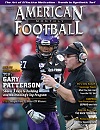AMERICAN FOOTBALL MONTHLY THE #1 RESOURCE FOR FOOTBALL COACHES
|
|
Article Categories
|
Running Back Pass Protection Progression Drillsby: Robin BowkettRun-Game Coordinator and Running Backs Coach Salve Regina University © More from this issueAt Salve Regina, our running backs have many philosophies. One of them that they take great pride in and stress the most is to “protect the ball and protect the QB”. I will go through some of our pass protection techniques that we do and how they build up into a progression.
SHUFFLE
One of the more important and stressed techniques in pass protection is having the proper shuffle. We want to be in a good football position with flexion in our ankles, knees, and hips. Pretend like there is a ruler between our feet and a rubber band around our ankles and we want to take 6-inch steps. With this, we won’t click our heels together and we won’t gallop or take steps too big in our shuffle. Players also tend to get into trouble when they cross their feet and when they hop because in both instances they don’t ....The full article can only be seen by subscribers.
Subscribe today!

|
|
|
NOT A SUBSCRIBER?
Subscribe
now to start receiving our monthly magazine PLUS get INSTANT
unlimited access to over 4000 pages of 100 percent football coaching
information, ONLY available at AmericanFootballMonthly.com!
|
|
|
HOME
|
MAGAZINE
|
SUBSCRIBE
|
ONLINE COLUMNISTS
|
COACHING VIDEOS
|
Copyright 2025, AmericanFootballMonthly.com
All Rights Reserved






